

The latest indication of US inflation revealed some softness in price rises in April but does not remove considerable risk in the months ahead.
The US Bureau of Labor Statistics reported a 2.3% increase in the all items Consumer Price Index for the 12 months to the end of last month, down from 2.4% for the 12 months to the end of March. This marked the smallest rise since February 2021 and is well below April 2024’s 3.35%.
Although this moves inflation closer to where the Fed wants it, there remains the matter of tariffs and their inflationary impact, which will not yet be reflected in CPI data and will take a few months to be fully evident. Therefore, experts are not expecting any action from the Fed yet, even as President Trump again urged the central bank to act.
“We still anticipate them remaining on the sidelines in the near term and for markets to be trading with negotiation and reconciliation headlines,” said Alexandra Wilson-Elizondo, global co-head and co-chief investment officer of Multi-Asset Solutions within Goldman Sachs Asset Management.
John Kerschner, Head of US Securitized Products & portfolio manager at Janus Henderson said that “this was probably one of the least important CPI prints since the inflation spike of 2022,” given the overarching tariff situation.
Because of the delayed impact of the tariffs on inflation, he says “market uncertainty will likely remain elevated” until a clearer picture emerges.
Kerschner says the markets are pricing in only an 8% chance of a Fed cut in June and 41% in July compared to almost 100% a few weeks ago.
“We would expect that bond prices and rates would stay in the range they have been for most of 2025 until we get more clarity on the fluid tariff situation and the Fed's reaction function to at least some increase in inflation in the coming months,” he added.
Meanwhile, Gargi Chaudhuri, Chief Investment and Portfolio Strategist, Americas at BlackRock, explains what the inflation stats mean for portfolios.
“In stocks, even after developments in tariff negotiations, we think minimum volatility strategies make sense for investors who would otherwise sit in cash,” he said, adding that fixed income should focus on inflation protection. “In April, inflation protected bond ETFs added $792mn, extending the $1.8bn worth of flows in March. Short- and intermediate-term government bonds were in particular attention as investors rushed to safety during the market volatility. Short-term government bond ETFs received $44bn in inflows during April alone while intermediate term bonds added $6bn.”

Financial services compliance consultant ACA Group told InvestmentNews it had four clients report receiving emails that impersonated David Bottom, the SEC's chief information officer, with smaller firms being targeted.

Financial advisor Derek Wittjohann shares the lessons he learned after leaving a major wirehouse to set up his own practice in the second installment of InvestmentNews' new 'Independence Stories' series.

Whether a firm manages $50 million or $5 billion in client assets, building a succession strategy needs to be a priority at least a decade out from retirement.

RIA assets are key for broker-dealers right now.

The former investment advisor misled clients in a decade-long scheme to fund international travel expenses, country club fees, and other personal expenses, according to three government agencies.
Orion's Tom Wilson on delivering coordinated, high-touch service in a world where returns alone no longer set you apart.
Barely a decade old, registered index-linked annuities have quickly surged in popularity, thanks to their unique blend of protection and growth potential—an appealing option for investors looking to chart a steadier course through today's choppy market waters, says Myles Lambert, Brighthouse Financial.
